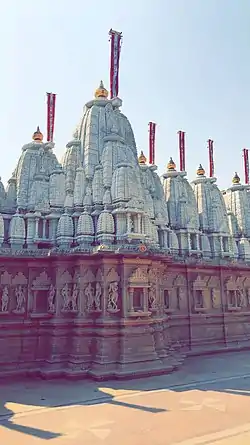Shankheshwar Jain Temple
The Shankheshwar Jain Temple is located in the center of Shankheshwar town of Patan district, Gujarat, India. The temple is dedicated to Parshwanath and is an important place of pilgrimage for the followers of Jainism.[2][3]
| Shankeshwar Jain Temple | |
|---|---|
 Shankeshwar Jain Temple | |
| Religion | |
| Affiliation | Jainism |
| Deity | Parshva |
| Festivals | Posh Dashami[lower-alpha 1], Mahavir Jayanti, Diwali |
| Location | |
| Location | Shankheshwar, Gujarat, India |
 Location within Gujarat | |
| Geographic coordinates | 23°30′29.3″N 71°47′15.6″E |
| Architecture | |
| Creator | Sajjan Shah |
| Date established | 1098 CE |
Mythology
In ancient scriptures, this Tirtha (pilgrimage site) is referred to as Shankhapur. The story is that Ashadhi Shravak became depressed, and began to ask questions about nirvana, liberation, and salvation. Answering all these questions, Damodar Swami, the ninth Tirthankar, said "Parshvanath will be the twenty-third Tirthankar in the Avasarpinikala (the descending half of the wheel of time). You will be his Ganadhar (prime disciple) named Aryaghosha and attain salvation there." Shravak then became fully absorbed in praying to Bhagawan Parshvanath and worshipping his idol, which went on to be worshipped in the worlds of gods, demons, and on earth.[4]
History
In the year 1155 VE (1098 CE), Sajjan Shah built the Shankheshwar Parshwanath Jain Temple temple on the banks of the Rupen river. In Vikram Samvat 1286 (1229 CE), Vastupal Tejpal renovated this temple under the instructions of Vardhamansuri. There were 52 idols in the temple. In VS 1302, the king, awed by the idol and inspired by Uktasuri, renovated the temple substantially. In the fourteenth century VS, the temple was destroyed by Alauddin Khalji. In the sixteenth century VS, under the inspiration of Vijaysensuri, a new temple with 52 idols was built. In VS 1760 (1703 CE), the sangha built the new temple and got the idol reinstalled. Besides the original sanctuary, the temple has an open square, a decorated square, a vast square and two assembly halls.[5] The current temple was built in 1811.[6]
About temples
The Mulnayak, that is the main idol, nearly 182 cm high, is a white-colored idol of Parshvanatha in the Padmasana posture. In Shvetambara tradition, idols tends to derive their name from a geographical region, the Shankheshwar Parshvanatha is one of 108 prominent idols of Parshvanath idols.[7] The idol of Bhidbhanjan Parshvanath is in a small temple to the right of the main idol, and the idol of Ajitnatha is in a small temple to the left of the main idol. The idols of Dharanendra, Padmavati, Parshva and Chakreshwari are also in the temple. On the tenth day of the month of Posh, the tenth day of the dark half of the month of Magasar, and during the Diwali days, thousand of pilgrims come to observe a two-day-long fast.
At present, the temple complex is under renovation. The doors of the small temples on the passage for going round the temple are being enlarged, and the height of their summits will be raised.
Other Jain temples
Besides this temple, there are several other Jain temples - the Agam Mandir,[8] the modern sprawling complex of 108 Parshvanath and Padmavati (108 Parshwanath Bhaktivihar Tirth), Rajendrasuri Navkar Mandir, Kalapurnam Smriti Mandir, the Gurumandir, and Dadawadi are important.
Shruth tirth[9] is located two kilometer southerly to Sankeshwar on Sankheswar-Viramgam Highway.
Further four kilometer south, there is Pavapuri Jalmandir at Ratanpura.[10]
Thus Shankeshwar tirth ranks next only to those on Mount Shatrunjaya in Palitana, (Gujarat) in terms of importance to the Swetambara Jains.
Gallery
.jpg.webp) Sculptures and Shikharas at Shankheswar Jain Temple
Sculptures and Shikharas at Shankheswar Jain Temple.jpg.webp) Ornate carvings on wall
Ornate carvings on wall
Other buildings
There are an upashray, an ayambilshala, a bhandar, a pathshala, and a hall where food is given to pilgrims for their journeys.
Notes
- Posh Dashmi is the festival to celebrate the life of Parshvanatha.[1]
References
Citation
- Holt 2019, p. 260.
- Cort 2010, p. 186.
- http://www.jinalaya.com/gujarat/shankheshwar.htm
- http://www.jainsamaj.org/rpg_site/literature2.php?id=1369&cat=42
- http://www.speakingtree.in/blog/shankheshwar-jain-tirth
- Burgess 1876, pp. 187-217.
- Cort 2001, p. 234.
- http://www.india9.com/i9show/Shri-Agam-Mandir-Teerth-29372.htm
- http://www.pravachanshruttirth.org/
- http://www.pawapuritirth.org
Sources
- Burgess, James (1876), Report on the Antiquities of Kutch & Kathiawar: Being the Result of the Second Season's Operations of the Archaeological Survey of Western India, 1874-1875, London: India Museum, pp. 187, 217, archived from the original on 2015, retrieved 27 August 2016
- Cort, John E. (2001), Jains in the World: Religious Values and Ideology in India, Oxford University Press, ISBN 978-0-19-803037-9
- Cort, John E. (2010) [1953], Framing the Jina: Narratives of Icons and Idols in Jain History, Oxford University Press, ISBN 978-0-19-538502-1
- Holt, James D. (2019), Beyond the Big Six Religions, University of Chester, ISBN 9781908258984